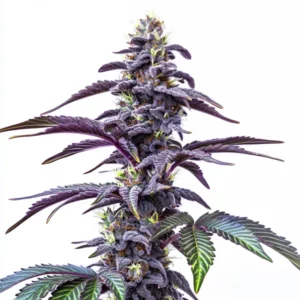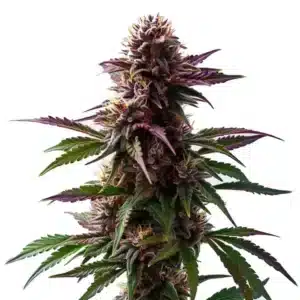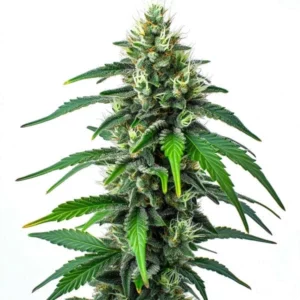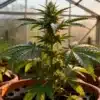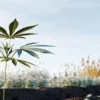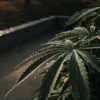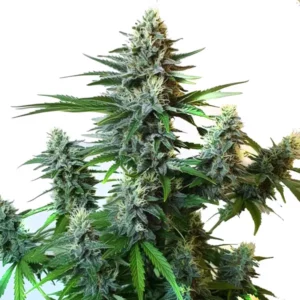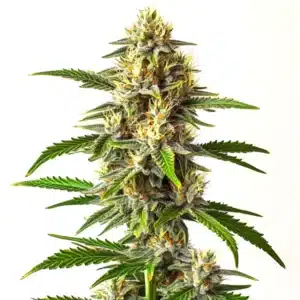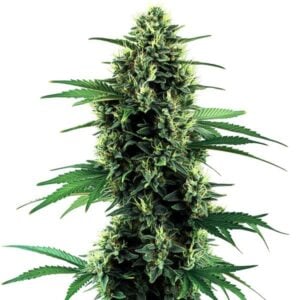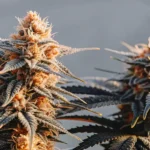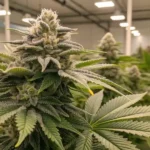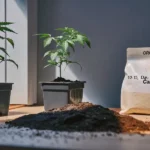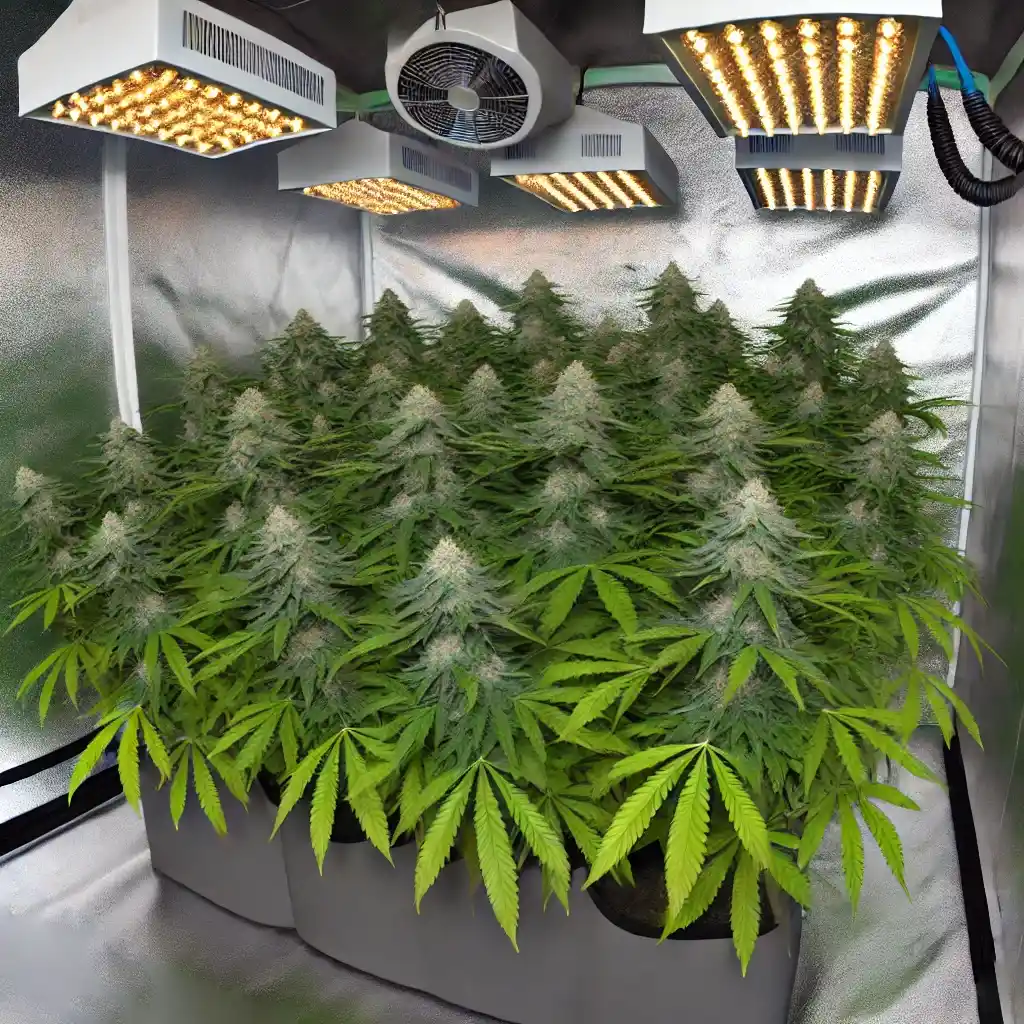
Best Auto for 3×3 Autoflower Yield
The Power of Auto Strains in a 3×3 Grow Tent
Understanding Autoflowering Strains
Best Auto for 3×3 Autoflower Yield. Autoflowering strains have revolutionized the way cannabis is cultivated, especially in small spaces like a 3×3 grow tent. Unlike traditional photoperiod plants, which require specific light cycles to transition from the vegetative stage to flowering, autoflowers bloom automatically based on age. This trait makes them incredibly versatile and efficient for growers looking to achieve optimal 3×3 grow tent yield in limited spaces.
Autoflowers are generally easier to manage because they don’t need a strict light schedule. They are perfect for beginners or those who want a more straightforward growing process. These strains typically have a shorter life cycle, allowing for quicker harvests, which means you can grow more cycles per year compared to photoperiod strains.
Recommended Strains
Fat Bastard
|
|
THC | 30% - 38% (High) |
|
|
Type | Feminized |
|
|
Yield | High |
|
|
Phenotype | 50% Indica / 50% Sativa |
Fat Bastard Auto
|
|
THC | 30% - 38% (High) |
|
|
Type | Autoflowering |
|
|
Yield | High |
|
|
Phenotype | 50% Indica / 50% Sativa |
Why Autoflowers Are Ideal for Small Grow Spaces
When working with a small grow space like a 3×3 tent, efficiency is key. Autoflowers are compact and tend to remain shorter than their photoperiod counterparts, making them ideal for environments where height is a concern. Their rapid growth and ability to flower under almost any light condition allow growers to maximize every inch of their grow tent, ensuring you achieve the Best Auto for 3×3 Autoflower Yield.
Another advantage is their resilience. Autoflowers are bred to be hardy and can withstand fluctuations in temperature and humidity better than many photoperiod strains. This resilience reduces the likelihood of issues that could compromise your yield, making them a reliable choice for growers operating in tight quarters.
Promos & Deals
Selecting the Best Auto Strains for 3×3 Autoflower Yield
High-Yield Autoflowering Strains
Yield is a critical factor when choosing the best autoflowering strains for your 3×3 tent. Some autoflowers are bred specifically for high yields, allowing you to make the most of your limited space. Strains like Gorilla Glue Autoflower F1 and Critical Mass Auto are known for producing dense, resinous buds that maximize harvest weight.
These strains not only produce large quantities of bud but also do so consistently, making them favorites among growers focused on yield. Choosing a high-yield strain ensures that your 3×3 tent delivers the best possible return on your investment in time and resources.
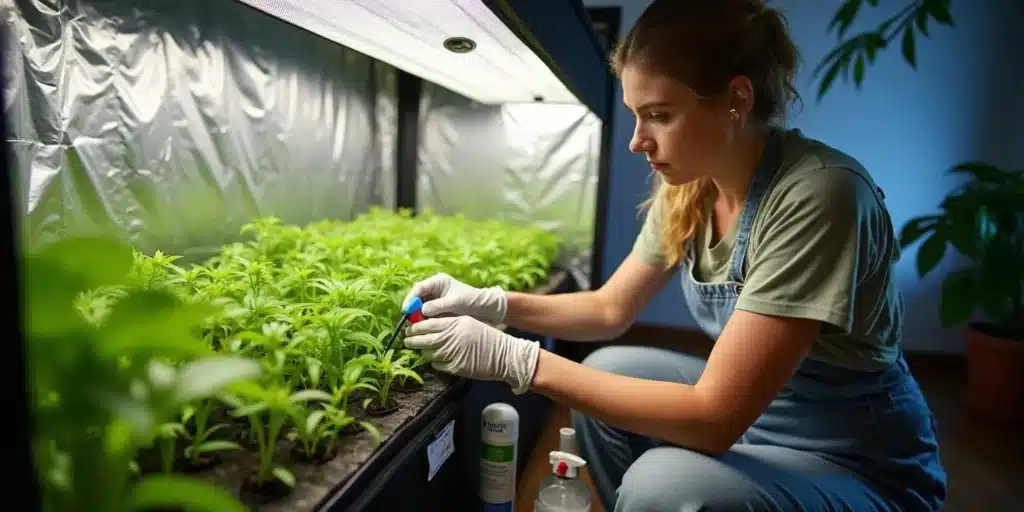
Fast-Growing Strains for Quick Harvests
In a 3×3 tent, time is of the essence. Fast-growing autoflower strain like Northern Lights Auto allow for quicker harvests, which is perfect for growers looking to cycle multiple crops throughout the year. These strains typically reach maturity in as little as 8 to 10 weeks from seed, enabling you to harvest and start the next cycle swiftly.
Fast-growing strains are particularly useful for those who want to experiment with different strains or who are cultivating cannabis for personal use and need a steady supply. By choosing strains that flower quickly, you can ensure that your grow tent remains productive year-round.
Compact Strains for Efficient Space Use
When space is at a premium, choosing compact strains can make a significant difference in your growing efficiency. Strains like Lowryder Auto are specifically bred to remain small, making them ideal for a 3×3 grow tent. These strains often stay under 2 feet in height, allowing you to use vertical space more effectively and possibly fit more plants into the tent.
Compact strains not only fit better in small spaces but also tend to be easier to manage. They often require less pruning and training, which can simplify your growing process. If maximizing the number of plants per square foot is your goal, compact autoflower strains are the way to go.
Strategies to Maximize Yield in a 3×3 Grow Tent
Optimizing Light Setup for Autoflowers
Light is one of the most critical factors in achieving high yields, especially in a confined space like a 3×3 tent. If you’re aiming for the Best Auto for 3×3 Autoflower Yield, it’s essential to provide the right environment. Autoflowers thrive under intense light, so investing in high-quality LED grow lights can significantly boost your results. Aim for lights that provide a full spectrum and cover every corner of your tent to ensure even growth and bud development.
Positioning your lights correctly is also crucial. Ensure that the lights are close enough to maximize light penetration but far enough to prevent light burn. Adjusting the light height as your plants grow will help maintain optimal conditions throughout the growth cycle.
Nutrient Management for Autoflowering Strains
Autoflowering strains have specific nutrient needs due to their fast growth cycle. Providing the right nutrients at the right time is essential to maximize yield, especially when you’re growing the Best Auto for 3×3 Autoflower Yield. During the vegetative stage, focus on nitrogen-rich fertilizers to support leafy growth. As the plants transition to flowering, switch to a phosphorus and potassium-rich formula to boost bud development.
It’s important to avoid overfeeding, as autoflowers are more sensitive to nutrient burn due to their shorter life cycle. Start with half the recommended dose and adjust based on your plants’ response. Regularly monitor pH levels to ensure that your plants are absorbing nutrients efficiently.
Proper Airflow and Temperature Control
Maintaining proper airflow and temperature in your 3×3 tent is vital for plant health and maximizing yield. Good airflow prevents mold and mildew, which can be detrimental in a small, enclosed space. Use oscillating fans to keep air moving, ensuring that every part of the plant receives fresh air.
Temperature control is equally important. Autoflowers thrive in temperatures between 70-85°F (21-29°C) during the day and slightly cooler temperatures at night. Keeping your tent within this range will promote healthy growth and increase the chances of a bountiful harvest.
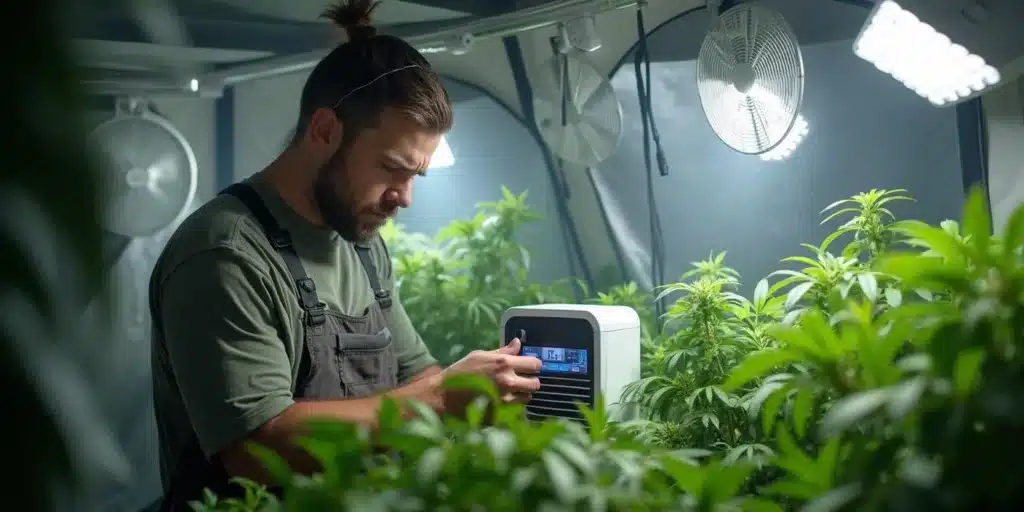
Avoiding Pitfalls: Common Mistakes in Growing Autoflowers in a 3×3 Tent
Overfeeding and Underfeeding
One of the most common mistakes growers make is overfeeding or underfeeding their autoflowers. Because autoflowers have a shorter life cycle, they don’t need as many nutrients as photoperiod plants. Overfeeding can lead to nutrient burn, which stunts growth and reduces yield. On the other hand, underfeeding can result in deficiencies that also hinder plant development.
To avoid these issues, start with lower nutrient doses and increase gradually if necessary. Pay close attention to your plants for signs of nutrient imbalances, such as yellowing leaves or slow growth. Adjust your feeding schedule accordingly to maintain optimal health.
Incorrect Light Cycles
While autoflowers can flower under almost any light cycle, optimizing the light schedule can significantly impact yield. An 18/6 light schedule (18 hours of light and 6 hours of darkness) is commonly used and provides a balance between energy efficiency and growth. Some growers use a 20/4 schedule to push for faster growth, but this requires more energy and can increase heat levels in the tent.
Sticking to a consistent light schedule ensures that your plants receive enough light to maximize photosynthesis without causing stress. Be cautious when experimenting with different schedules and always monitor your plants’ response.
Poor Space Management
In a 3×3 tent, every inch counts. Poor space management can lead to overcrowding, which reduces airflow and increases the risk of mold and pests. It can also cause plants to compete for light, leading to uneven growth and lower yields.
To manage space effectively, consider using low-stress training (LST) techniques to spread out the canopy and allow light to reach all parts of the plant. Regular pruning of lower branches can also help by focusing the plant’s energy on the top buds, where light penetration is strongest.
Making the Most of Your 3×3 Tent with the Right Autoflowers
By selecting the right autoflower strains and applying the best cultivation techniques, you can maximize your yields in a 3×3 tent. Remember, the key to success lies in understanding the unique needs of autoflowers and creating an environment that supports their rapid growth and development. With careful planning and attention to detail, even a small grow space can produce impressive results.
Invest in quality seeds from reputable breeders, optimize your lighting and nutrient regimens, and don’t be afraid to experiment with different training techniques. Whether you’re a beginner looking to get started or an experienced grower seeking to refine your methods, focusing on the fundamentals will help you achieve the best possible outcomes with your autoflowers in a 3×3 tent.
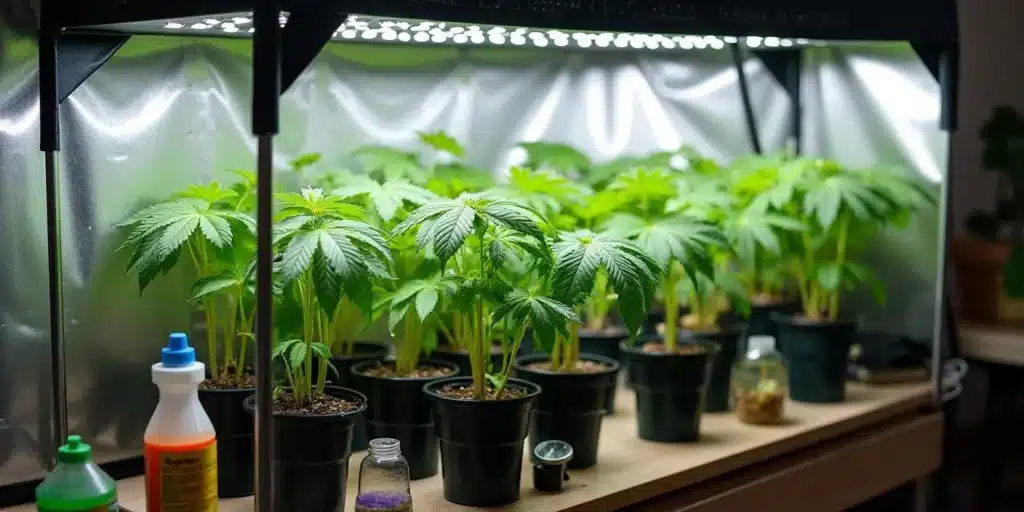
FAQs About Growing Auto Strains in a 3×3 Autoflower Yield
How Many Autoflower Plants Can I Grow in a 3×3 Tent?
Most growers find that 4 to 6 autoflowering plants fit comfortably in a 3×3 tent, depending on the strain and training techniques used. This number allows for adequate space between plants, ensuring they receive enough light and airflow to thrive.
What is the Ideal Light Schedule for Autoflowers in a 3×3 Tent?
Autoflowers typically thrive under an 18/6 light schedule, which provides 18 hours of light and 6 hours of darkness daily. Some growers use a 20/4 schedule for faster growth, but this may require more precise temperature and humidity control.
How Can I Maximize Yield in a Small Grow Space Like a 3×3 Tent?
To maximize yield in a small grow space, focus on optimizing light intensity, maintaining proper nutrient levels, and ensuring good air circulation. Low-stress training (LST) can also help increase bud production by allowing more light to reach lower branches.
What is the Average Yield I Can Expect From an Autoflower in a 3×3 Tent?
Yields can vary widely depending on the strain and growing conditions, but many growers achieve between 1 to 2 ounces per plant. With optimal conditions, including proper lighting, nutrients, and space management, you can expect even higher yields.
Do Autoflowering Plants Need Special Nutrients?
Autoflowers have similar nutrient needs to photoperiod plants but may require lower doses due to their shorter life cycle. It’s essential to monitor your plants and adjust feeding schedules based on their growth stage and overall health.
Can I Grow Autoflowers Alongside Photoperiod Plants in the Same Tent?
Yes, you can grow autoflowers alongside photoperiod plants, but you’ll need to manage light schedules carefully. Photoperiod plants require a strict light/dark cycle to flower, whereas autoflowers do not. Consider using light deprivation techniques or separate light schedules to accommodate both plant types.
What are the Best Training Techniques for Autoflowers in a 3×3 Tent?
Low-stress training (LST) and topping are popular techniques to maximize yield in a confined space. However, be cautious with high-stress techniques, as they can stunt the growth of autoflowers. LST helps create an even canopy and allows more light to reach all parts of the plant.
What is the Ideal Light Schedule for Autoflowers in a 3×3 Tent?
Autoflowers are known for their versatility when it comes to lighting schedules. Unlike photoperiod plants, which require specific light and dark cycles to flower, autoflowers will bloom under almost any light conditions. However, to maximize their potential, most growers opt for an 18/6 light schedule, meaning 18 hours of light followed by 6 hours of darkness. This schedule strikes a good balance between giving your plants enough light for robust growth and providing them with a period of rest to prevent stress.
Some advanced growers push the envelope with a 20/4 light schedule, which gives the plants more light each day, potentially increasing growth rates. However, this can also lead to higher electricity costs and increased heat in your grow tent, which requires careful management. For those looking to optimize yields in a 3×3 tent without overcomplicating their setup, the 18/6 schedule is often the best choice, especially when growing the Best Auto for 3×3 Autoflower Yield.
How Can I Maximize Yield in a Small Grow Space Like a 3×3 Tent?
Maximizing yield in a small grow space like a 3×3 tent requires a combination of strategies that optimize every aspect of the growing environment. Start with your lighting—make sure you are using high-quality LED grow lights that provide full-spectrum light and cover the entire tent evenly. Position your lights at the correct distance from the canopy to ensure optimal light penetration without causing light burn.
In addition to lighting, pay close attention to your nutrient schedule. Autoflowers have a rapid growth cycle, so providing them with the right nutrients at the right time is crucial. Use a balanced fertilizer during the vegetative stage and switch to a bloom-focused formula once the plants start flowering. Regularly monitor pH levels to ensure nutrient uptake is not hindered.
Space management is also critical in a small tent. Consider using low-stress training (LST) to spread the plant’s canopy, allowing more light to reach lower branches and buds. This technique can significantly increase the number of bud sites and, consequently, your overall yield. Finally, maintain excellent airflow with fans to prevent mold and ensure consistent temperature and humidity levels.
What is the Average Yield I Can Expect From an Autoflower in a 3×3 Tent?
Yield expectations can vary based on several factors, including the strain, growing conditions, and the grower’s experience level. On average, autoflowering plants can produce between 1 to 2 ounces per plant in a 3×3 tent. However, if you’re aiming for the Best Auto for 3×3 Autoflower Yield, with optimal conditions such as perfect lighting, nutrient balance, and effective space management some growers report yields as high as 3 to 4 ounces per plant.
The key to achieving higher yields lies in consistency and attention to detail. Regularly check your plants for signs of stress or nutrient deficiencies, and make adjustments as needed. By fine-tuning your environment and using proven growing techniques, you can push your plants to produce their maximum potential, resulting in a rewarding harvest.
Do Autoflowering Plants Need Special Nutrients?
Autoflowering plants have nutrient requirements that are similar to photoperiod plants, but they are typically less demanding due to their shorter life cycle. Autoflowers tend to be more sensitive to nutrient burn, so it’s important to start with lower doses of fertilizer and gradually increase as needed. During the vegetative stage, focus on providing nitrogen-rich nutrients to support foliage growth.
As the plants transition into flowering, switch to a bloom fertilizer that is higher in phosphorus and potassium, which are crucial for bud development. Be mindful of overfeeding, as this can lead to nutrient lockout and reduced yields. Regularly flush your plants with plain water to prevent salt buildup and maintain a healthy root zone.
Organic nutrients are often recommended for autoflowers, as they are generally gentler on the plants and less likely to cause nutrient burn. Many growers also supplement with beneficial microbes to enhance nutrient uptake and improve overall plant health.
Can I Grow Autoflowers Alongside Photoperiod Plants in the Same Tent?
Yes, it is possible to grow autoflowers alongside photoperiod plants in the same tent, but it requires careful planning and management. The primary challenge is managing the light schedule, as photoperiod plants require a strict light/dark cycle (typically 12/12) to initiate and sustain flowering, while autoflowers do not.
One solution is to use light deprivation techniques, such as covering the photoperiod plants during their dark period, while allowing the autoflowers to continue receiving light. Alternatively, you can grow the autoflowers under the same light schedule as the photoperiod plants, although this may slightly reduce the potential yield of the autoflowers.
Another option is to separate the tent into different sections using a light-proof divider, allowing you to maintain different light schedules within the same tent. This setup is more complex but can be highly effective for maximizing the productivity of both plant types.
What are the Best Training Techniques for Autoflowers in a 3×3 Tent?
Training techniques can significantly impact the yield and quality of your autoflower plants, especially in a confined space like a 3×3 tent. Low-Stress Training (LST) is one of the most popular methods for autoflowers. It involves gently bending and tying down the main stem and branches to create a more even canopy, allowing light to penetrate deeper into the plant and reach lower bud sites. This technique can increase the number of colas and result in a higher overall yield.
Topping is another technique used by some growers, though it is more controversial with autoflowers due to their short vegetative stage. Topping involves cutting the main stem to encourage the plant to grow multiple colas instead of a single main one. If done early and carefully, topping can be effective, but it carries the risk of stunting the plant’s growth if not timed correctly.
In a small grow tent, maximizing space is crucial. Consider combining LST with other techniques like defoliation, where you remove some of the fan leaves to allow more light to reach the buds. However, be cautious not to stress the plant too much, as autoflowers don’t have as much time to recover as photoperiod plants.




